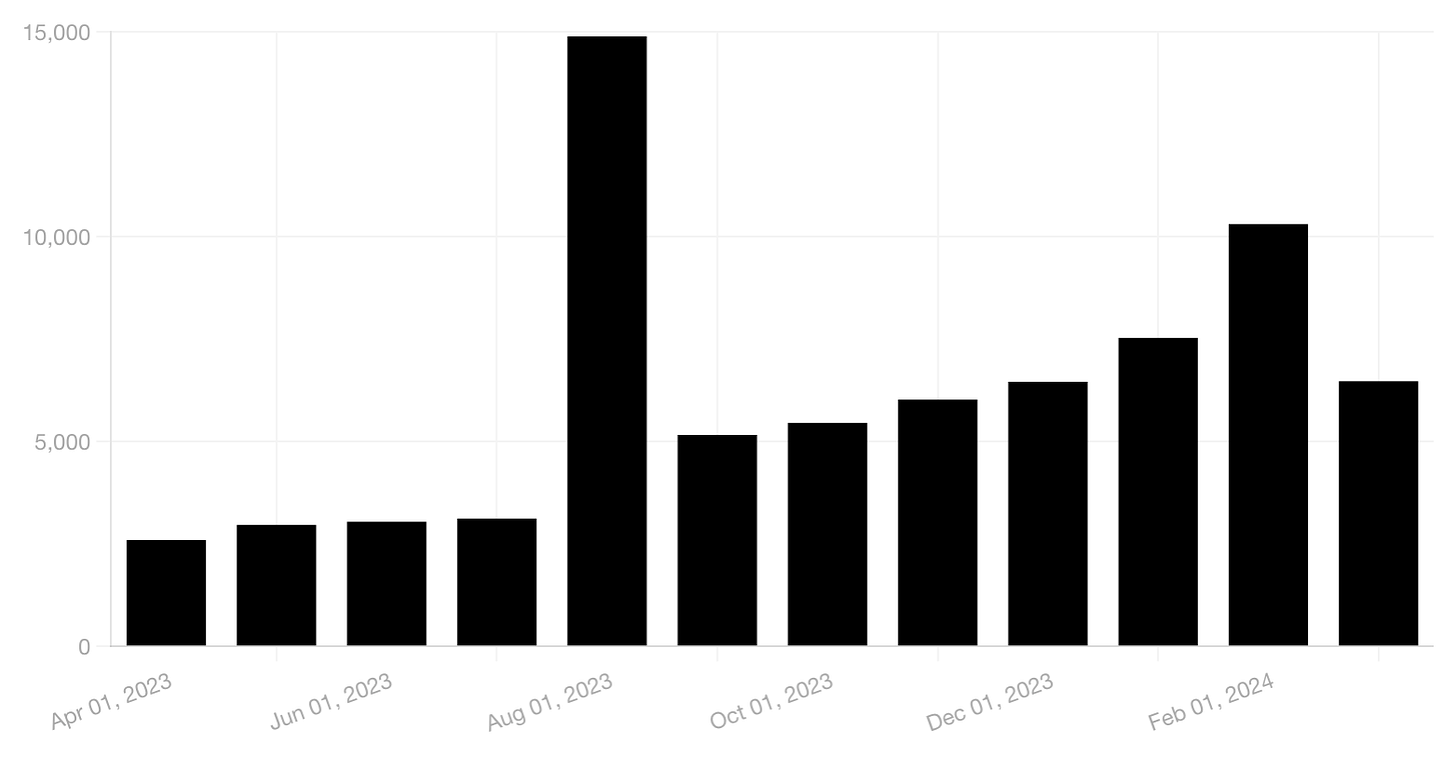One Year Anniversary Special
Post and subscriber stats revealed, plus what's next for Have You Played
tl,dr: I’m moving Have You Played to my blog. No need to do anything except check your spam if you don’t see anything for a while. I’ll be writing more broadly about entertainment and technology as well as games, and posting a little less often as I ramp up my research for a book about the history and future of immersive entertainment. Also, I’m taking it easy having left my job of 17 years!
It’s Have You Played’s one year anniversary! Along with two posts from guests, I’ve covered 49 games, from console blockbusters and real world experiences to indie web and VR games. Maintaining a weekly pace while running a company has been tough, with barely a day between hitting “publish” and starting the next game.
But I’m not complaining! I had a few reasons for starting this newsletter, and the first one was giving myself an excuse to play more games. The reason why it was hard is the same reason why it was necessary: making games can be a tiring, time-consuming process and it was hard to motivate myself to play after work, especially games outside of my comfort zone. After making mostly smartphone fitness games for over a decade, I felt I didn’t have a good grasp of the full breadth of video games.

I also wanted to write about games in a different way than I’ve seen elsewhere. I joke to friends, in an admittedly mean-spirited way, that games writing all too often begins with three paragraphs about how the author loved going fishing with their grandfather as a kid, after which you finally get a sketch of Animal Crossing. I don’t have anything against that kind of writing when done well, but if all writing is like that, it becomes difficult to know what a game is actually like to play – moreso if you aren’t familiar with the genre. It’s not unusual for me to read 500 words about a new game and still be mystified about what it is you do in it.
Hence Have You Player’s matter of fact introductions and detailed descriptions of game mechanics and controls and progression. It’s not because I’m fussy (though I am), but because I think these things are interesting and important. I’m fascinated why a little game like The Exit 8 becomes so popular; it’s not just because it’s about “the backrooms” or liminal spaces, it’s because of countless deliberate choices.
My focus on the nuts and bolts of game design has, I fear, led some to think that’s all I write about. If you’re still reading my newsletter, you’ll know this isn’t true – I just like to serve the vegetables before dessert. My tale of Viewfinder’s narrative crimes has done the rounds amongst many game designers I admire, but it only makes sense if I’ve explained how the game works. That I bury my hot takes might explain why I haven’t reached as many readers as I’d hoped.
Weirdly, I imagined my main audience would be the general public – people who were curious about games but didn’t know much about them. Instead, the majority of my 800+ subscribers are from the games and tech industry. At first, I was a little disappointed, but it’s ended up being a blessing.
See, I have a mild inferiority complex when it comes to game design. I worry my experience making ARGs and fitness games isn’t super applicable towards more conventional video games. Writing about 50 games in a year was my attempt to disprove that. My lower subscriber numbers, then, are more than made up by the respect of my peers. In fact, at least a quarter of my posts have been read by the game’s creators, who’ll sometimes kindly send a note or an email, even when they disagree with me.
Now, onto the good stuff!
Most Viewed Posts
Star Wars: Galactic Starcruiser (12,300 views)
The Exit 8 (7700 views)
Cityscapes: Sim Builder (3000 views)
The Cosmic Wheel Sisterhood (1800 views)
Mars After Midnight (1500 views)
Most Liked Posts
Star Wars: Galactic Starcruiser (27 likes)
The Exit 8 (12 likes)
The Invincible (11 likes)
Phantom Peak (11 likes)
Honkai: Star Rail (10 likes)
These stats are a little misleading because newer posts haven’t had the chance to accumulate as many views and likes. As such, it’s impressive that Mars After Midnight hit 1500 views after just one week.
Notably missing are the most popular games I’ve covered: Spider-Man 2, Starfield, and Cyberpunk 2077. While I think I have interesting things to say about those games, I can’t blame people for overlooking yet another post on games that have been discussed to death.
Instead, it’s “under-discussed games” that have really drawn the crowds. That isn’t the same as “niche” or “indie” – Honkai: Star Rail is immensely popular, but there isn’t much writing about it for more general audiences. The same goes for my 12,000 word epic on the Star Wars hotel, which got a lot of visitors despite reports to the contrary, but is still one of the only longform articles that goes deep into the details of its immersive experience.
The Exit 8 stands out for a different reason. GameDiscoverCo Plus estimates it having sold half a million copies, no small feat, but still quite a bit less than other games I’ve covered. It’s certainly under-covered, lacking proper reviews on the big game sites, but here’s the real reason why my post is so popular:
That’s right – Google blessed my post as its official source on the game. Anyone searching for “The Exit 8” will see my description first. Pretty cool! Other posts aren’t blessed, but still rank highly on Google, like for Cityscapes: Sim Builder, Mars After Midnight, and Puzzmo. Evergreen content, baby!
View by month
Overall view of my newsletter have climbed steadily over time. The peak in August is for the Star Wars post, which got a lot of attention and links, and February is when The Exit 8 started doing the numbers. I’m sure this month will be lower.
Notably, half of my views now come from posts older than a month.
Subscriber growth
I don’t do any growth hacks, nor any Substack recommendation swaps, and I prefer not to harp on about the newsletter on my socials. As a result, my subscriber growth has been gradual, with peaks when a few posts were shared widely on other newsletters and social media thanks to Antony Johnston, Simon Carless, Cory Doctorow, Kathryn Yu, and others. I’m sure I could have a lot more subscribers if I tried harder but… I don’t want to. I enjoy writing and that’s where I choose to spend my energy.
My posts average a 55% open rate and since the start of the year they’ve been attracting around a thousand views each. That’s not the same as individual readers, mind you – if one person opens an email ten times, that gets counted as ten views.
Some of the posts I’m most proud of haven’t been very popular, like Viewfinder (which pairs nicely with The Invincible), Roadwarden, and Sunset. I feel like I’ve said something different and new in those posts, which is what I really care about.
What’s next?
For the time being, I’ll continue to write more or less as I have done so far, but less frequently. I’ll also mix in posts about other things I’m interested in across entertainment and technology – feel free to skip those!
Despite all my talk of numbers and views, Have You Played is a hobby. I don’t rely on it for money so I don’t need to change it. But just as a thought exercise, what if I went all-in on growing it?
If I stuck with the current format but ramped up to a hundred games a year, I’d expect to have thousands of subscribers in a few years time. Pretty good, but I’m not sure how I’d monetise without making even more stuff and putting it behind a paywall.
A possible route would be to zero in on my games industry audience by creating a kind of paid database of in-depth analysis going even further than my current posts, including video captures; a way for designers to quickly learn about other games without spending hours playing them. Game Developer and GDC already do this, but it’s usually designers writing about their own games (so they don’t have to pay them!). Nothing wrong with that, but it’s not the same as serious criticism from independent writers. Would people pay for this? No idea.
Going in the opposite direction, rather than writing 50 posts about 50 games, I could do what most sensible websites do and write 50 posts about the five most popular games. This would save me untold hours: playing 50 games a year isn’t like watching 50 films a year, it’s like learning 50 new hobbies a year. In other words, inadvisable.

Even if I wanted to do that, there are plenty of sites with hot takes about the biggest games and no-one needs another. In fact, the demand for written games journalism seems to be waning. As Nathan Grayson put it on The Aftermath, “after a certain age level, a lot of people just don't read about games anymore,” preferring video from TikTok, YouTube, and Twitch.
So, pivot to video? I’m not tempted. Video editing is difficult and time consuming, plus YouTube’s ever-changing algorithms demand a punishing schedule from creators. I could try a podcast, but I’d need to find a co-host and/or regular guests, which is a lot of work, and there are already a ton of good games podcasts.
The fact is that I like writing and I think I’m pretty good at it. So, why a newsletter and not something else? I used to write a column for EDGE magazine, for example.
Well, like social media, newsletters as a format are so successful at delivering addictive feedback to hyperlexic writers that they’re pulling them away from all other formats. Write two thousands words for a newsletter and the moment you press publish, the views and the likes and the comments roll in. Write two thousand words for a book and nothing happens at all. Once you’ve written 100,000 words, for twelve months still nothing happens except your words gets increasingly outdated. When it’s finally published, people will say you’re a genius, though they’re probably being polite because no-one reads non-fiction books any more.
I’m exaggerating, of course, and books tend to have a better shelf life than newsletters. Even better, readers come with the expectation, however misguided, that book authors have developed deeper and more complex arguments than those in newsletters. That’s why people take you more seriously and give you nice consulting gigs once you’re a Published Author.
I would love for there to be something that’s the best of both worlds, though: a way to write something big and substantial but regularly get confidence-boosting feedback; a way to reach lots of people without it feeling ephemeral or left to fortune. But with the demise of magazines and newspapers, the space for this kind of writing is shrinking.
What’s the solution? In the same conversation on The Aftermath, Jason Schreier suggested:
I think you have to kind of meet people where they're at. The newspaper of record these days, The New York Times, is doing all sorts of multimedia stuff. They have podcasts and newsletters. It's trying to reach people wherever they are. I think that is ultimately the solution. That's not to say every website should be trying to do everything. It's kind of recognizing the audience you're trying to pursue and doing it that way.
Like others, I’ve been thinking hard about this problem. In my head, I imagine something called a Fast Publishing Platform, and I intend to experiment with it for the immersive entertainment book I’m writing. It’ll still be a book-like object but it’ll be more multimedia, more accessible, and have more of a sense of community and immediacy than traditional books.
It’s probably a terrible idea! But as always, I can’t wait to try something new.










Great to read your thoughts. numbers, and there are still a few of our posts I haven't read yet and would like to circle back to. It's also good to read as I'm considering to restart my own newsletter and thinking about what I want to write about. I'll be looking out for the blog updates and the book too (I read non-fiction too)! Thanks.
Hello from the general public 👋🏻 haha! Looking forward to reading your upcoming blog posts as I enjoyed reading your comments in the old CS Discord.